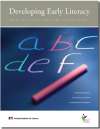Developing Early Literacy
Conventional reading and writing skills that are developed in the years from birth to age 5 have a clear and consistently strong relationship with later conventional literacy skills. Additionally, six variables representing early literacy skills or precursor literacy skills had medium to large predictive relationships with later measures of literacy development. These six variables not only correlated with later literacy as shown by data drawn from multiple studies with large numbers of children but also maintained their predictive power even when the role of other variables, such as IQ or socioeconomic status (SES), were accounted for. These six variables include:
- alphabet knowledge (AK): knowledge of the names and sounds associated with printed letters
- phonological awareness (PA): the ability to detect, manipulate, or analyze the auditory aspects of spoken language (including the ability to distinguish or segment words, syllables, or phonemes), independent of meaning
- rapid automatic naming (RAN) of letters or digits: the ability to rapidly name a sequence of random letters or digits
- RAN of objects or colors: the ability to rapidly name a sequence of repeating random sets of pictures of objects (e.g., “car,” “tree,” “house,” “man”) or colors

Source: National Institute for Literacy
Download Full Report
